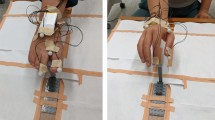Abstract
Neurophysiologic studies have shown differences in brain activation between pointing and grasping movements. We asked whether these two movement types would differ in their cognitive costs of motor planning. To this end, we designed a sequential, continuous posture selection task, suitable to investigate pointing and grasping movements to identical target locations. Participants had to open a column of drawers or point to a column of targets in ascending and descending progression. The global hand pro/supination at the moment of drawer/target contact was measured. The size of the motor hysteresis effect, i.e., the persistence to a former posture, was used as a proxy for the cognitive cost of motor planning. A larger hysteresis effect equals higher cognitive cost. Both motor tasks had similar costs of motor planning, but a larger range of motion was found for the grasping movements.





Similar content being viewed by others
Notes
Please note that slope refers to the parameter in the sigmoid function y = 0.5 · range · tanh(slope · (x − offset)). The real slope of the two sigmoid functions, which results from the combined effect of the slope and range parameter, is not the same. This difference, however, is due to the difference in the range parameter, not in the slope parameter.
References
Atkeson CG, Hollerbach JM (1985) Kinematic features of unrestrained vertical arm movements. J Neurosci 5:2318–2330
Bernstein NA (1967) The co-ordination and regulation of movements. Pergamon Press Ltd., Oxford
Bockemühl T, Troje NF, Dürr V (2010) Inter-joint coupling and joint angle synergies of human catching movements. Hum Mov Sci 29:73–93
Debicki DB, Gribble PL (2005) Persistence of inter-joint coupling during single-joint elbow flexions after shoulder fixation. Exp Brain Res 163:252–257
Faillenot I, Toni I, Decety J, Grégoire MC, Jeannerod M (1997) Visual pathways for object-oriented action and object recognition: functional anatomy with PET. Cereb Cortex 7:77–85
Harris CM, Wolpert DM (1998) Signal-dependent noise determines motor planning. Nature 394:780–784
Hogan N (1984) An organizing principle for a class of voluntary movements. J Neurosci 4:2745–2754
Jax SA, Rosenbaum DA, Vaughan J, Meulenbroek RGJ (2003) Computational motor control and human factors: modeling movements in real and possible environments. J Hum Fact Ergon Soc 45:5–27
Jordan MI, Wolpert DM (1999) Computational motor control. In: Gazzaniga M (ed) The cognitive neurosciences. MIT Press, Cambridge
Kelso JAS, Buchanan JJ, Murata T (1994) Multifunctionality and switching in the coordination dynamics of reaching and grasping. Hum Mov Sci 13:63–94
Latash ML, Aruin AS, Shapiro MB (1995) The relation between posture and movement: a study of a simple synergy in a two-joint task. Hum Mov Sci 14:79–107
Matsumoto M, Nishimura T (1998) Mersenne twister: A 623-dimensionally equidistributed uniform pseudo-random number generator. ACM Trans Model Comput Simul 8:3–30
Matsumura M, Kawashima R, Naito E, Satoh K, Takahashi T, Yanagisawa T, Fukuda H (1996) Changes in rCBF during grasping in humans examined by PET. NeuroReport 7:749–752
Mayergoyz ID (1991) Mathematical models of hysteresis. Springer, New York
Oldfield RC (1971) The assessment and analysis of handedness: the edinburgh inventory. Neuropsychologica 9:97–113
Rosenbaum DA, Jorgensen MJ (1992) Planning macroscopic aspects of manual control. Hum Mov Sci 11:61–69
Rosenbaum DA, Engelbrecht SE, Bushe MM, Loukopoulos LD (1993) Knowledge model for selecting and producing reaching movements. J Mot Behav 25:217–227
Rosenbaum DA, Meulenbroek RJ, Vaughan J, Jansen C (2001) Posture-based motion planning: applications to grasping. Psychol Rev 108:709–734
Rosenbaum DA, Cohen RG, Jax SA, Weiss DJ, van der Wel RPRD (2007) The problem of serial order in behavior: Lashley’s legacy. Hum Mov Sci 26:525–554
Rosenbaum DA, Chapman KM, Weigelt M, Weiss DJ, van der Wel R (2012) Cognition, action, and object manipulation. Psychol Bull 138:924–946
Schütz C, Schack T (2013a) Influence of mechanical load on sequential effects. Exp Brain Res 228:445–455
Schütz C, Schack T (2013b) Motor primitives of pointing movements in a three-dimensional workspace. Exp Brain Res 227:355–365. doi:10.1007/s00221-013-3516-2
Schütz C, Schack T (2013c) Prospective and retrospective effects in a virtual pointing task. Acta Psychol 142:314–322
Schütz C, Weigelt M, Odekerken D, Klein-Soetebier T, Schack T (2011) Motor control strategies in a continuous task space. Mot Control 15:321–341
Short MW, Cauraugh JH (1997) Planning macroscopic aspects of manual control: end-state comfort and point-of-change effects. Acta Psychol 96:133–147
Stöckel T, Hughes CL, Schack T (2012) Representation of grasp postures and anticipatory motor planning in children. Psychol Res 76:768–776. doi:10.1007/s00426-011-0387-7
Weigelt M, Schack T (2010) The development of end-state comfort planning in preschool children. Exp Psychol 57:476–482
Weigelt M, Rosenbaum DA, Hülshorst S, Schack T (2009) Moving and memorizing: motor planning modulates the recency effect in serial and free recall. Acta Psychol 132:68–79
Acknowledgments
This work was supported by the Cluster of Excellence Cognitive Interaction Technology ‘CITEC’ (EXC 277) at Bielefeld University, which is funded by the German Research Foundation (DFG).
Author information
Authors and Affiliations
Corresponding author
Rights and permissions
About this article
Cite this article
Schütz, C., Weigelt, M. & Schack, T. Cognitive costs of motor planning do not differ between pointing and grasping in a sequential task. Exp Brain Res 234, 2035–2043 (2016). https://doi.org/10.1007/s00221-016-4608-6
Received:
Accepted:
Published:
Issue Date:
DOI: https://doi.org/10.1007/s00221-016-4608-6




